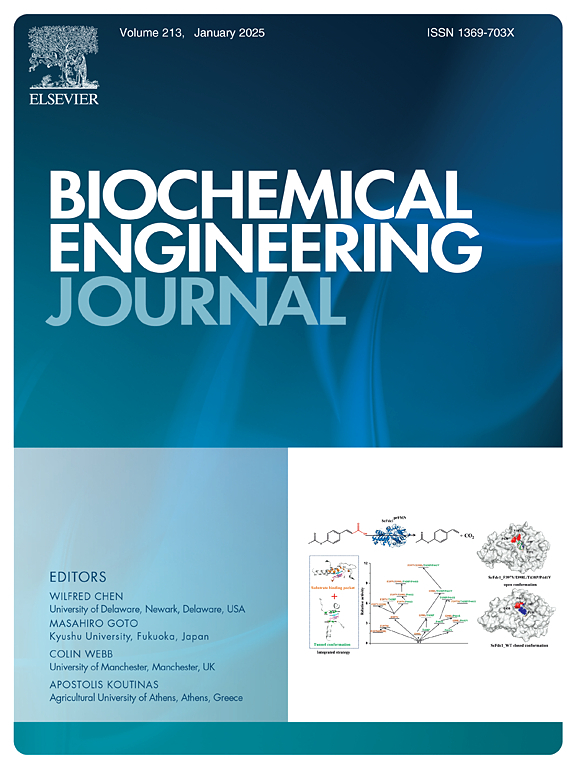Optimization of phenyllactic acid biosynthesis and separation by machine learning with neural network and overlay sampling uniform design
IF 3.7
3区 生物学
Q2 BIOTECHNOLOGY & APPLIED MICROBIOLOGY
引用次数: 0
Abstract
Machine learning methodology with neural network models was developed using the datasets based on the overlay sampling uniform design (OSUD) for optimization of phenyllactic acid biosynthesis and separation processes by cryogels. Compared with the multiple regression, the machine learning models exhibited a significant improvement of predictive accuracy of phenyllactic acid biosynthesis, in which the radial basis function neural network (RBFNN) model had the best predictive performance with the accuracy increased by 65.2 %. The combination of RBFNN and OSUD was further employed to optimize the chromatographic separation of phenyllactic acid from crude fermentation broth using two poly(hydroxyethyl methacrylate) based anion-exchange cryogel packed-beds (grafted with (vinylbenzyl)trimethylammonium chloride and N,N-dimethylaminoethyl methacrylate). After optimizing the three critical separation parameters: sample volume (5.3–31.8 mL), flow velocity (1.0–6.0 cm/min), and elution salt concentration (0.05–0.3 mol/L), it was found that the models provided excellent predictions. The optimized recovery rates for the two packed-beds were determined to be 76.5 % and 83.0 %, and the optimal adsorption capacities were 0.26 mg/mL and 0.39 mg/mL from the fermentation broth, respectively. This study provides a reliable integrated approach for optimizing the synthesis and separation processes of high-value bioproducts like phenyllactic acid from crude feedstocks.
利用神经网络和叠加采样统一设计的机器学习优化苯乳酸的生物合成和分离
利用基于叠加抽样均匀设计(OSUD)的数据集开发了神经网络模型的机器学习方法,用于优化苯乳酸的生物合成和冷凝胶的分离过程。与多元回归相比,机器学习模型显著提高了苯乳酸生物合成的预测精度,其中径向基函数神经网络(RBFNN)模型的预测性能最佳,精度提高了 65.2%。研究人员进一步将 RBFNN 和 OSUD 结合使用,优化了使用两种聚(甲基丙烯酸羟乙酯)阴离子交换冷凝胶填料床(接枝有(乙烯基苄基)三甲基氯化铵和 N,N-二甲基氨基甲基丙烯酸甲酯)从粗发酵液中分离苯乳酸的色谱分离过程。在对样品体积(5.3-31.8 mL)、流速(1.0-6.0 cm/min)和洗脱盐浓度(0.05-0.3 mol/L)这三个关键分离参数进行优化后,发现模型提供了极好的预测。两种填料床的最佳回收率分别为 76.5 % 和 83.0 %,对发酵液的最佳吸附容量分别为 0.26 mg/mL 和 0.39 mg/mL。这项研究为优化从粗原料中合成和分离苯乳酸等高价值生物产品的过程提供了一种可靠的综合方法。
本文章由计算机程序翻译,如有差异,请以英文原文为准。
求助全文
约1分钟内获得全文
求助全文
来源期刊

Biochemical Engineering Journal
工程技术-工程:化工
CiteScore
7.10
自引率
5.10%
发文量
380
审稿时长
34 days
期刊介绍:
The Biochemical Engineering Journal aims to promote progress in the crucial chemical engineering aspects of the development of biological processes associated with everything from raw materials preparation to product recovery relevant to industries as diverse as medical/healthcare, industrial biotechnology, and environmental biotechnology.
The Journal welcomes full length original research papers, short communications, and review papers* in the following research fields:
Biocatalysis (enzyme or microbial) and biotransformations, including immobilized biocatalyst preparation and kinetics
Biosensors and Biodevices including biofabrication and novel fuel cell development
Bioseparations including scale-up and protein refolding/renaturation
Environmental Bioengineering including bioconversion, bioremediation, and microbial fuel cells
Bioreactor Systems including characterization, optimization and scale-up
Bioresources and Biorefinery Engineering including biomass conversion, biofuels, bioenergy, and optimization
Industrial Biotechnology including specialty chemicals, platform chemicals and neutraceuticals
Biomaterials and Tissue Engineering including bioartificial organs, cell encapsulation, and controlled release
Cell Culture Engineering (plant, animal or insect cells) including viral vectors, monoclonal antibodies, recombinant proteins, vaccines, and secondary metabolites
Cell Therapies and Stem Cells including pluripotent, mesenchymal and hematopoietic stem cells; immunotherapies; tissue-specific differentiation; and cryopreservation
Metabolic Engineering, Systems and Synthetic Biology including OMICS, bioinformatics, in silico biology, and metabolic flux analysis
Protein Engineering including enzyme engineering and directed evolution.
 求助内容:
求助内容: 应助结果提醒方式:
应助结果提醒方式:


